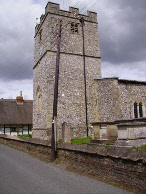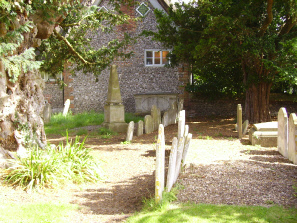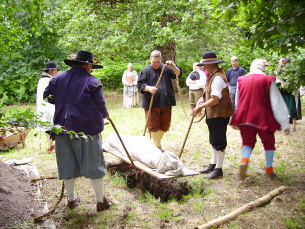An insight into Parish life through extracts from parish registers
- Extracts Relating to Parochial Expenses etc.
The basis of our present system of relieving the poor in England originated in the famous Act of Elizabeth 1601, the professed objects of which were “to set the poor to work, to relive the lame, impotent, old, and blind, and to put out their children as apprentices.”
It was required in carrying out these objects that a fund
should be raised, in every parish in England, for the maintenance of its own poor.
The application of this fund was placed in the hands of the parish officers, justices
of the peace having control over it. Another object of the Act was the subjecting
of able-
About eight years after this, an Act was passed in the reign
of James 1st, ordering houses of correction to be built, provided with mills, and
other appurtenances, for the purpose of setting the vagrant able-
- Extracts from the old parish books
The necessity of preserving extracts of this kind needs no advocacy, for it is to be regretted that parochial records too frequently find a depository in damp places in vestry rooms, in badly constructed ecclesiastical chests, and even in the church tower, and become the prey of mildew and spider.
Although many of the entries from the parish books of St.
Mary Bourne will be found merely trivial and amusing, collectively they throw some
light on past parochial history. From them we are enabled to learn what two hundred
years have done in matters of education, as well as in the prices of some of the
commodities of life. We find reference to diseases then rife, and how they were
treated; with extracts bearing on the operations of past laws, such as the old poor
laws. We also learn a little respecting some old families; and there are notices
concerning church usages’ and repairs, together with references to curious old books
which were formerly employed in the church for public reading. Also what was done
at vestries, and who conducted them. The earliest entry refers to the year 1633;
but my first extract will be from the year 1635-
- The Salisbury and Winchester Journal Saturday April 19th . 1833
- Coroner’s Report.
Westmeon.-
Richard Privett, who hung himself to a bar in his chamber window, deceased was a man of good character, but very poor, willing to work even beyond his strength, but so severely afflicted with rheumatism, that he was not equal to much hard labour, thus compelled to seek parochial relief, he was in the habit of receiving 5s. Every Saturday, towards the support of himself and his wife and his daughter. But the pittance was doled out to him so unfeeling a manner, that the poor fellow could not bear to apply for it, and declared on the Friday preceding his death “that his life was a misery to him”. At length, on Friday last dreading the approaching day, he committed the fatal act. Which terminated his existence, on the following morning, his widow applied for the usual allowance, which was paid to her, with a notice, that in future she was to expect half that sum, and if she applied to the parish to bury her husband, her goods would be seized to defray the expenses! Verdict Insanity.
- Extracts from the parish registers (1)
1635-
1659 Pd. Wm. Merry for going for ye bone setter 1s.
1661-
1676-
1683-
1683-
1686 Given to two impoverished by the sea. (About this time a good deal of money appears to have been paid yearly to maimed soldiers and sailors.)
1687-
1719-
1721-
1729-
1731-
1739-
Susanah the wife of Stephen Burgis was delivered of 3 children,
2 sons and one daughter May 31-
1782-
Afterwards 2s.6d. For a horse to have Charles Lewis to Kingsclere.
1786-
1803 and 1814.Only three marriages are recorded in each year, probably on account of the younger men having gone as soldiers. (Dr. Joseph Stevens)
 Some of those mentioned
as " Bone setters and treating "bad legs" were commonly herbalists
of some local repute, who practised healing by "simples" (dried herbs)
before the passing of the apothecaries act in 1815, anyone could practice medicine,
The last member of this fraternity wandered about the North Hampshire villages as
late as 1865 dispensing gathered herbs in a dried state to the poor. He was an odd
retiring kind of man, whose confidence it was difficult to obtain, but he once informed
me that some of his simples were of but little service in healing unless they were
"gathered at some particular phase of the moon". He sold a kind of soap
stated to contain Solomon’s seal for removing discolorations and freckles from the
skin. Other helpers at times of sickness were aged matrons, who did their best with
homely remedies.
Some of those mentioned
as " Bone setters and treating "bad legs" were commonly herbalists
of some local repute, who practised healing by "simples" (dried herbs)
before the passing of the apothecaries act in 1815, anyone could practice medicine,
The last member of this fraternity wandered about the North Hampshire villages as
late as 1865 dispensing gathered herbs in a dried state to the poor. He was an odd
retiring kind of man, whose confidence it was difficult to obtain, but he once informed
me that some of his simples were of but little service in healing unless they were
"gathered at some particular phase of the moon". He sold a kind of soap
stated to contain Solomon’s seal for removing discolorations and freckles from the
skin. Other helpers at times of sickness were aged matrons, who did their best with
homely remedies.
A Dr. Batter of Market Lavington in Wiltshire, was a happy specimen of such, and really possessed considerable practical skill. He was a poor man, and lived in a cottage by the road side, where his ancestors for a generation or two had lived before him, and practiced as a bone setter. It was his custom to take his chair and table out alongside of a hedge, and having seated his patients he proceeded to prescribe for them with herbs gathered near, and his extensive acquaintance with wild plants and there localities enabled him to direct his visitors where to find what they wanted in the neighbourhood of their own homes. (Dr. Joseph Stevens)
The reference to "a sisting" Charles Lewis might I think be more truthfully rendered by the substitution of the word "coercing". That these marriages were compulsory there can be no doubt, for in the next entry we find "expenses of taking up", etc. such transactions were wasteful of the poor rates, and demoralising to the people, they were nevertheless of frequent occurrence under the old bastardy law, which positively gave encouragement to female unchastity. An allowance of money was made for each illegitimate child, so that the means increasing with every spurious addition, a woman with several such became as well provided for as a mother with a similar number of lawful children. The same law, further, subjected the putative father to punishment often at the woman’s discretion, rendering him liable to the alternative of marriage or the prison. Of course he commonly chose the former as the least of the two present evils. All this was however small compared with the consequences of such influence on the female character. Where these measures largely prevailed chastity ceased to be valued as a virtue. In short, the woman as well as her husband and parents became in a great measure indifferent to it. (Dr. Joseph Stevens)
- Extracts from the parish registers (2)
1683-
1686-
1687-
1705-
1705-
1714-
1720-
After this foxes were killed in increasing numbers, from twenty to thirty yearly. The Bourne authorities appear to have bought them from any other neighbourhood, mention being made of Andover, Litchfield, Vernham, "Don Husburn", "Up husburn", etc. It is evident that the destruction of poultry and game by foxes, stoats, polecats, etc, and even lambs by foxes, determined the churchwardens to exterminate them in every way possible. Two shillings each seems to have been about the regular price. The destruction of the animal began to wane at about the end of the eighteenth century. In 1735, twenty four foxes are mentioned; and in 1765, £1.12s. Was paid for "Fockes" If similar purchases were made in other parishes the slaughter must have been enormous. The heavy, slow, old fashioned harrier then occupied the place of the modern dashing foxhound; hare hunting formed the principal sport of the country squire. There was more woodland as shelter for foxes; and a good deal of the land now under cultivation was down, as shown by the names of Wadwick down, Eggbury down, Week down, the greater part of which, if not the whole, being now arable. (Dr. Joseph Stevens)
- Extracts from parish registers (3)
1635-
1669-
1708-
1709-
1715-
1729-
1733-
1738-
1740-
1746-
Occasionally there are familiar entries, Christian names
being omitted, as-
1750-
1751-
(The Piper here referred to lived at Butler’s farm, which belonged to him at one time. He did not get on very well and ultimately sold the property.)
1759-
1764-
1766-
1759- the grave so reports say, to prevent the remains from being disturbed." The
practice of planting a yew tree in a church yard was usually when the burial ground
was to be extended and consecrated often the ceremony was carried out by the bishop.
the grave so reports say, to prevent the remains from being disturbed." The
practice of planting a yew tree in a church yard was usually when the burial ground
was to be extended and consecrated often the ceremony was carried out by the bishop.
There is a notice dated Wednesday, Oct. 25th, 1848, that a new piece of land to enlarge the churchyard was consecrated. The bishop was to plant a yew tree, which was to be called "The Bishop's yew". (This was done on the day of consecration.) The land here alluded to enlarge the graveyard on the east; and was presented to the parish by the late Mr. Thomas Longman of Diplands, and the late Mr. John Longman of Warwick.
Among the papers is one executed on May 20th.1884, by which Ann Elizabeth Longman of Wadwick, in the parish of St. Mary Bourne grants and conveys to the person or persons in whom the churchyard of the parish is now vested, and his successors, a piece of land of 27 perches, on the north side of the churchyard, as an addition to the churchyard for burial purposes. (Dr. Joseph Stevens)
1 720-
720-
The grave cloth of the period of the entry must have been of wool, the employment of wool at that time compulsory. During the middle ages it was customary to wrap the dead in the sheet or shroud usually without a coffin; and the practise often led to the placing of the body in a grave with the face downwards.
In the act 30th of Charles 2nd entitled "An act for the lessening the importation of linen from beyond the seas, and the encouragement of the woollen and paper manufactures of the Kingdom", the use of wool was insisted on to encourage the consumption and increase the trade of the clothiers and wool growers. The Act was repealed by George 3rd. in 1814.The curate of every parish was required to keep a register of all the burials in woollen. There was a fine for evading the act, which was willingly paid by some who were desirous to decorate the dead with lace, and even kid gloves, as in the case of Mrs. Oldfield who died in 1731.Even the ligatures of the feet and the coffin dressing were required to be of wool. The practice then in vogue has its survival in the present woollen shroud. (Dr. Joseph Stevens)
- Extracts from the Churchwardens books / Overseers accounts and Rate book
April-
Feb 27th.in the year 1781-
1782-
1784 -
1787-
Feb 14th. 1796 Amy daughter of Mary Phillips was born baptised Mar 25th, 1796 baseborn.
1804-
1808-
1808-
1808 Apl.23rd.The shandelear was put up, gave by Mrs. Hannah Longman.
1809-
1813-
1813 -
1826 St. Mary Bourne church clock was donated by Richard Poore of St. Mary Bourne.
(It seems the clock needed regular repair and maintenance as there is constant reference to it in the parish book.) (Kevin Holdway)
1849. First mention of Church Insurance £1.2s.6d.per year
(Dr. Joseph Stevens)
- The Parish vestry
Important functions in the life of the parish continued to be performed by the parish vestry meetings till 1894. After which the Parish council took over in accordance with the local government act of the same year. It made assessments for rates, fixed the poor rate, and each year appointed overseers, Guardians and Way wardens. At the Easter Monday Vestry, the Churchwardens were appointed for the ensuing year. The Churchwardens accounts, pew assessments, etc, were presented to a parish Vestry Meeting. Between 1884 and 1894 rates varied from 10d. To 1/6d. In the £1.
The last meeting of the parish vestry was held on October 11th, 1894. Mr. Selfe was chairman. The rate was fixed at 1/6d in the £. Assessments were apportioned on some property of Mr. James Neale, who was present, and “this concluded the business of the parish vestry”.
One of the biggest parish vestry meetings recorded was held
on August 12th.1882,”for
the purpose of enabling the rate-
John Berry and William Day were the churchwardens present, and Alfred Charles Medhurst and James Eyles the Overseers.
Twenty three rate payers assembled, including two – Charles Davis and William Longman – who arrived after the decision that the bridge was desirable had been carried unanimously, and added their assent; and thirteen voted by proxy including six women, (none being present). S. Lockheart, vicar, was chairman.
A foot bridge was erected and is useful for pedestrians when the Bourne flows at the foot of Baptist hill. Other “traffic” still splashes through the water. (Kathleen Innes 1946)